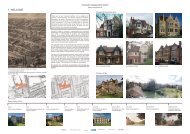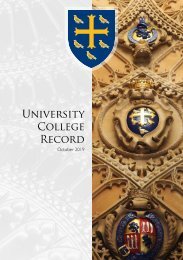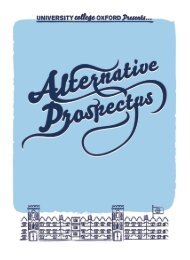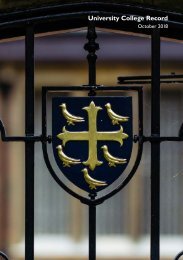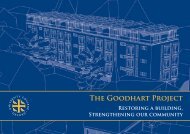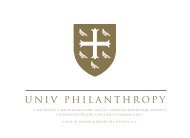Create successful ePaper yourself
Turn your PDF publications into a flip-book with our unique Google optimized e-Paper software.
EDMUND JOHN NOBLE WILSON (Liverpool Institute High<br />
School) died on 3 November 2016 aged 78. Jim Williamson (1956)<br />
has kindly supplied this obituary prepared by his family:<br />
Edmund Wilson, known as “Eddie” at Oxford and later<br />
as “Ted”, a particle physicist and visiting professor at Oxford<br />
<strong>Univ</strong>ersity and former head of CERN Accelerator School, died<br />
after a short illness on 3rd November.<br />
He was born on 18 March 1938 in Liverpool, the son of school<br />
teacher John Wesley Wilson and nurse Anna Wilson. His passion<br />
for mathematics and physics was quickly recognized by his teachers<br />
at the Liverpool Institute High School for Boys, leading him to be<br />
accepted at Oxford <strong>Univ</strong>ersity, where he graduated in Physics in 1959. Ted first worked in<br />
experimental particle dynamics at the Rutherford Laboratory but soon became interested<br />
in the theory of particle accelerators. He moved to Switzerland in 1967, to become righthand<br />
man to Sir John Adams, the “father” of the giant particle accelerators, preparing<br />
the design of the Super Proton Synchrotron (SPS), which was CERN’s first underground<br />
accelerator – seven kilometres in circumference and stretching across the border between<br />
Switzerland and France. During SPS construction, Ted spent a sabbatical at Fermilab<br />
near Chicago, where he brought his experience to bear in coaxing Fermilab’s new 500<br />
GeV synchrotron into life. Ted returned to CERN to lead the commissioning of SPS<br />
before joining CERN’s ground breaking Antiproton Accumulator team which converted<br />
the SPS into a proton–antiproton collider. It was while working in this ground that Ted<br />
established a strong friendship with Fang Shouxian, the director of China’s Institute<br />
of High Energy Physics, who had been seconded by the Chinese government to work<br />
with the physicists at CERN on the antiproton accumulator project. That friendship<br />
led Ted to travel to China on a number of occasions in the early 1980s as a guest of the<br />
government in a period when there were few links of any kind between China and the<br />
West. It is difficult to appreciate today just how unusual such collaboration was at that<br />
time. Ted achieved this in part through force of personality, a great sense of humour and<br />
natural diplomacy but also his underlying belief, gained through his work at CERN, in<br />
the value of international scientific collaboration. Throughout his career he worked with<br />
laboratories across the globe, including Germany, Russia, the US and Japan. He was also<br />
a true internationalist: in his private life he met his German wife Monika, while working<br />
in Switzerland and took Swiss nationality after 50 years of residence. In the later stages<br />
of his career and in retirement Ted turned his attention to inspiring international groups<br />
of young mathematicians and physicists in the design and use of particle accelerators in<br />
a variety of applications including medical science. He spent twelve years as head of the<br />
CERN Accelerator School and then rekindled his connection with Oxford <strong>Univ</strong>ersity,<br />
becoming Visiting Professor in Oxford’s John Adams Institute for Accelerator Science<br />
where he taught post-graduate students. Ted believed the language of mathematics to be<br />
deeply intertwined with the language of music and this showed in his lifelong passion<br />
for classical music and opera. He was a keen and talented amateur pianist and singer and<br />
never happier than on his frequent visits to the opera. He was the author of two works on<br />
accelerators: Engines of Discovery and An Introduction to Particle Accelerators.<br />
Ted is survived by his wife Monika; three sons, Martin, Alexander and Nicholas and<br />
five grandchildren.<br />
78<br />
1957<br />
IAN ARTHUR LEESON (Rugby) died on 22 December 2016 aged 79. He read PPE at <strong>Univ</strong>.<br />
He qualified as an accountant, and became a partner in Ernst and Whinney (later Ernst and<br />
Young). His father Alister and one of his daughters, Sally, came up to <strong>Univ</strong> in 1931 and 1986<br />
respectively.<br />
1958<br />
JOHN HORSLEY RUSSELL DAVIS (Christ’s<br />
Hospital) died on 15 January <strong>2017</strong> aged 78. He<br />
read History at <strong>Univ</strong>, after which he moved to<br />
the LSE as a postgraduate. In 1966 he moved to<br />
the <strong>Univ</strong>ersity of Kent, where he later became a<br />
Lecturer in Sociology at the <strong>Univ</strong>ersity of Kent,<br />
and then a Professor of Social Anthropology. One<br />
of his main achievements there was to found the<br />
Centre for Social Anthropology and Computing<br />
in 1985. In 1990 he was returned to Oxford when<br />
he was elected Professor of Social Anthropology,<br />
a post which brought with it a Fellowship of All Souls, and then he served as Warden<br />
of All Souls in 1995-2008. He was appointed a Fellow of the British Academy in 1988.<br />
Professor Simon Green, a colleague from All Souls, writes: “John took everything he did<br />
seriously. What made him so strikingly different from Englishmen of his generation was<br />
to be as serious about leisure as labour, or pleasure as pain. John revelled in his friends, and<br />
was possessed by a genuine, and endearing, need for friendship. He kept on making friends<br />
throughout his life, routinely adding to, rather than subtracting from their number.” [The<br />
portrait of John Davis by Andrew Festing reproduced here is copied by permission of the<br />
artist and of All Souls College.]<br />
1960<br />
ERIC DAVIS EARLE (Memorial <strong>Univ</strong>ersity of Newfoundland and <strong>Univ</strong>ersity of British<br />
Columbia) died on 24 December 2016 aged 79. Davis Earle came to <strong>Univ</strong> as a Rhodes<br />
Scholar and a postgraduate in Physics. His D. Phil. thesis, titled “Collision studies of low<br />
energy particles with nuclei” was completed in 1964. His former colleague at the Sudbury<br />
Neutrino Observatory, Professor Art McDonald, co-winner of<br />
the Nobel Prize for Physics in 2015, sums up Davis’s scientific<br />
career as follows:<br />
“Davis had a solid career in nuclear physics at Oxford<br />
during his graduate studies and at Chalk River Nuclear<br />
Laboratories in the 1960s and 1970s, specializing in nuclear<br />
reactions initialized by neutrons from nuclear reactors. In<br />
1984, he was one of the 16 founders of the Sudbury Neutrino<br />
Observatory (SNO) international scientific collaboration that<br />
carried out a highly unique set of measurements leading to the<br />
award of the 2015 Nobel Prize and the 2016 Breakthrough<br />
79




